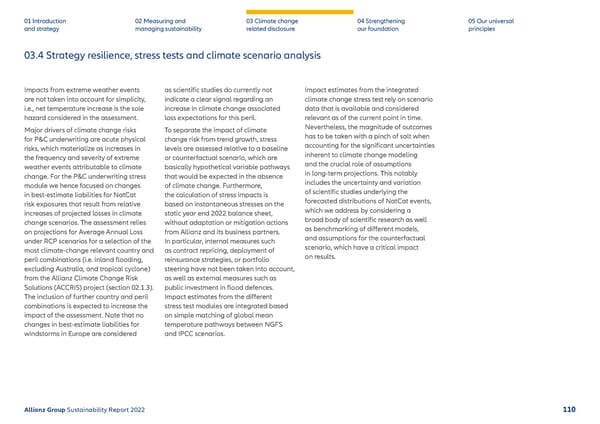03.4 Strategy resilience, stress tests and climate scenario analysis 01 Introduction and strategy 02 Measuring and managing sustainability 03 Climate change related disclosure 04 Str engthening our foundation 05 Our universal principles Impacts from extreme weather events are not taken into account for simplicity, i.e., net temperature increase is the sole hazard considered in the assessment. Major drivers of climate change risks for P&C underwriting are acute phy sical risks, which materialize as increases in the frequency and severity of extreme weather events attributable to climate change. For the P&C underwriting stress module we hence focused on changes in best-estimate liabilities for NatCat risk exposures that result from relative increases of projected losses in climate change scenarios. The assessment relies on projections for Average Annual Loss under RCP scenarios for a selection of the most climate-change relevant country and peril combinations (i.e. inland flooding, excluding Australia, and tropical cyclone) from the Allianz Climate Change Risk Solutions (ACCRiS) project (section 02.1.3). The inclusion of further country and p eril combinations is expected to increase the impact of the assessment. Note that no changes in best-estimate liabilities for windstorms in Europe are considered as scientific studies do currently not indicate a clear signal regarding an incr ease in climate change associated loss expectations for this peril. To separate the impact of climate change risk from trend gro wth, stress levels are assessed relative to a baseline or counterfactual scenario, which are basically hypothetical variable pathways that would be expected in the absence of climate change. Furthermore, the calculation of stress impacts is based on instantaneous stresses on the static year end 2022 balance sheet, without adaptation or mitigation actions from Allianz and its business partners. In particular, internal measures such as contract repricing, deployment of reinsurance strategies, or portfolio steering have not been taken into account, as well as external measures such as public investment in flood defences. Impact estimates from the different stress test modules are integrated based on simple matching of global mean temperature pathways between NGFS and IPCC scenarios. Impact estimates from the integrated climate change stress test rely on sc enario data that is available and considered relevant as of the current point in time. Nevertheless, the magnitude of outcomes has to be taken with a pinch of salt when accounting for the significant uncertainties inherent to climate change modeling and the crucial role of assumptions in long-term projections. This notably includes the uncertainty and variation of scientific studies underlying the forecasted distributions of NatCat events, which we address by considering a broad body of scientific research as well as benchmarking of different models, and assumptions for the counterfactual scenario, which have a critical impact on results. Allianz Group Sustainability Report 2022 110
 Sustainability Report 2022 | Allianz Page 110 Page 112
Sustainability Report 2022 | Allianz Page 110 Page 112